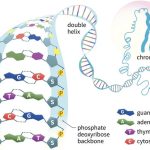Introduction to DNA Damage and Repair:
DNA is a highly stable and versatile molecule. Though sometimes the damage is caused to it, it is able to maintain the integrity of information contained in it. The perpetuation of genetic material from generation to generation depends upon keeping the rates of mutation at low level. DNA has many elaborate mechanisms to repair any damage or distortion.
The most frequent sources of damage to DNA are the inaccuracy in DNA replication and chemical changes in DNA. Malfunction of the process of replication can lead to incorporation of wrong bases, which are mismatched with the complementary strand. The damage causing chemicals break the backbone of the strand and chemically alter the bases. Alkylation, oxidation and methylation cause damage to bases. X-rays and gamma radiations cause single or double stranded breaks in DNA.
A change in the sequence of bases if replicated and passed on to the next generation becomes permanent and leads to mutation. At the same time mutations are also necessary which provide raw material for evolution. Without evolution, the new species, even human beings would not have arisen. Therefore a balance between mutation and repair is necessary.
Types of Damage:
Damage to DNA includes any deviation from the usual double helix structure.
1. Simple Mutations:
Simplest mutations are switching of one base for another base. In transition one pyrimidine is substituted by another pyramidine and purine with another purine. Trans-version involves substitution of a pyramidine by a purine and purine by a pyrimidine such as T by G or A and A by C or T. Other simple mutations are detection, insertion of a single nucleotide or a small number of nucleotides. Mutations which change a single nucleotide are called point mutations.

2. Deamination:
The common alteration of form or damage includes deamination of cytosine (C) to form uracil (u) which base pairs with adenine (A) in next replication instead of guanine (G) with which the original cytosine would have paired.
As uracil is not present in DNA, adenine base pairs with thymine (T). Therefore C-G pair is replaced by T-A in next replication cycle. Similarly, hypoxanthine results from adenine deamination.
3. Missing Bases:
Cleavage of N-glycosidic bond between purine and sugar causes loss of purine base from DNA. This is called depurination. This apurinic site becomes non-coding lesion.
4. Chemical Modification of Bases:
Chemical modification of any of the four bases of DNA leads to modified bases. Methyl groups are added to various bases. Guanine forms 7- methylguanine, 3-methylguanine. Adenine forms 3-methyladenine. Cytosine forms 5- Methylcytosine.
Replacement of amino group by a keto group converts 5-methylcytosine to thymine.

5. Formation of Pyrimidine Dimers (Thymine Dimers):
Formation of thymine dimers is very common in which a covalent bond (cyclobutyl ring) is formed between adjacent thymine bases. This leads to loss of base pairing with opposite stand. A bacteria may have thousands of dimers immediately after exposure to ultraviolet radiations.
6. Strand Breaks:
Sometimes phosphodiester bonds break in one strand of DNA helix. This is caused by various chemicals like peroxides, radiations and by enzymes like DNases. This leads to breaks in DNA backbone. Single strand breaks are more common than double strand breaks.

Sometimes X-rays, electronic beams and other radiations may cause phosphodiester bonds breaks in both strands which may not be directly opposite to each other. This leads to double strand breaks.
Some sites on DNA are more susceptible to damage. These are called ho


